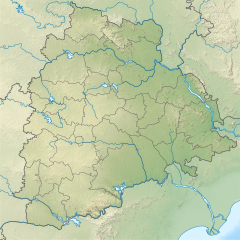| Alampuram Navabrahma Temples | |
|---|---|
 Svarga Brahma Temple | |
| Religion | |
| Affiliation | Hinduism |
| District | Jogulamba Gadwal district |
| Deity | Shiva, others |
| Location | |
| Location | Alampuram (Hemalapuram) |
| State | Telangana |
| Country | India |
| Geographic coordinates | 15°52′40.1″N 78°08′5.4″E / 15.877806°N 78.134833°E |
| Architecture | |
| Style | Nagara |
| Completed | 7th century |
| Temple(s) | 9 |
Alampuram Navabrahma Temples are a group of nine early Badami Chalukyan Hindu temples dated between the 7th and 9th centuries that are located at Alampuram (Hemalapuram) in Telangana, India, near the meeting point of Tungabhadra River and Krishna River at the border of Andhra Pradesh.[1] They are called Nava-Brahma temples though they are dedicated to Shiva. They exemplify early North Indian Nagara style architecture with cut rock as the building block. The temples of Alampur resemble the style of Pattadakal, Aihole style as they were Karnata Dravida, Vesara style native to Karnataka.[1]
The temples are significant for their east-facing simple square plans, intricate carvings of themes of Shaivism, Vaishnavism and Shaktism. They also contain early examples of friezes that narrate legends from Hindu texts such as the Panchatantra fables.[2] The temples were a significant influence on the later era Kakatiya Hindu temples.[3]
These temples were built by the Badami Chalukyas rulers, and early 8th-century inscriptions found at the site suggest that the site also had a Shaiva matha (Hindu monastery) which has not survived.[4] Their ruins have been restored by the Archaeological Survey of India after 1980.[5][6]
The Alampuram Navabrahma temples were badly damaged and defaced during the Islamic invasion of this region in and after the 14th century.[7][8][5] A series of religious wars and conquest led to the construction of an Islamic fort, a mosque and a graveyard called Shah Ali Pedda Dargah being built midst the Navabrahma temples over the 15th to 17th centuries. This construction was completed in part using the temple walls and ruined masonry from the temples, according to Ghulam Yazdani – an archaeologist who surveyed these temples and the Islamic monuments among them in 1926–27 for the Nizam of Hyderabad.[9] The Hindus abandoned worship in temples in immediate vicinity of these Sultanate-era additions.[9]
- ^ a b George Michell (2013). Southern India: A Guide to Monuments Sites & Museums. Roli Books. pp. 318–321. ISBN 978-81-7436-903-1.
- ^ Marijke J. Klokke (2000). Narrative Sculpture and Literary Traditions in South and Southeast Asia. BRILL. pp. 78–82. ISBN 90-04-11865-9.
- ^ Madhusudan A. Dhaky; American Institute of Indian Studies (1996). Encyclopaedia of Indian temple architecture. American Institute of Indian Studies. pp. 423, 447. ISBN 978-81-86526-00-2.
- ^ B. Rajendra Prasad (1983). Chalukyan Temples of Andhradesa. Abhinav Publications. pp. 8–9. ISBN 978-0-391-02853-1.
- ^ a b "Alampur surfaces after six days". The Hindu. 8 October 2009. Archived from the original on 10 October 2009.
- ^ ASI yet to assess damage to Kurnool structures – Times Of India
- ^ The Andhra Pradesh Journal of Archaeology. Director of Archaeology and Museums, Government of Andhra Pradesh. 1984. pp. 80–81.
- ^ Pedarapu Chenna Reddy (2006). Readings in Society and Religion of Medieval South India. University of Hyderabad, Research Press. pp. 99–100. ISBN 978-81-89131-04-3.
- ^ a b Ghulam Yazdani (1929), Annual Report of the Archaeological Department of His Exalted Highness the Nizam's Dominions for 1336 F (1926-1927 AD), Archaeological Department of Hyderabad, Baptist Mission Press, pp. 8–11; for contemporary image, see Muslim Fort and Shah Ali’s Dargah, 17th Century CE

